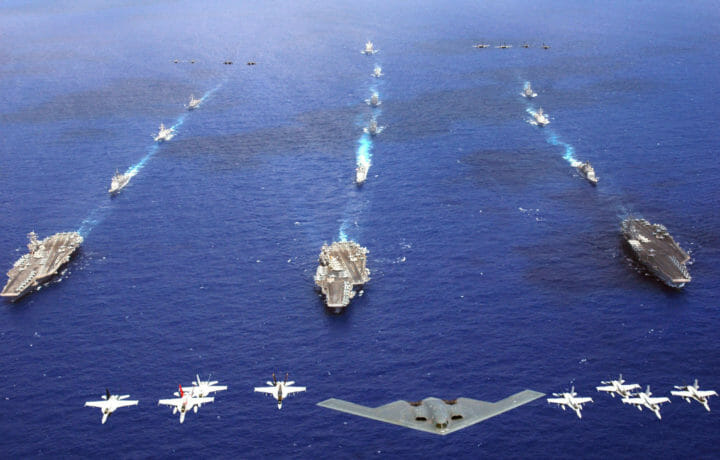Despite the government shutdown, the weeklong celebration of the United States Navy and United States Marine Corps continued in Philadelphia, which included a parade of ships and a military flyover along the Delaware River last Thursday. The San Antonio-class amphibious transport dock USS Arlington (LPD-24), joined by the Arleigh Burke-class USS Lassen (DDG-82), and the Freedom-class Littoral Combat Ships USS Billings (LCS-15) and USS Cooperstown (LCS-23) took part in the parade, escorted up the river by firefighting boats turned into floating fountains.
The parade along the waterfront of the City of Brotherly Love occurred just before the official anniversary of the founding of the Continental Navy in Philadelphia on October 13, 1775. The United States Marine Corps was founded less than a month later, on November 10, also in Philadelphia.
The Origins of the U.S. Navy
Although the Declaration of Independence wouldn’t be signed until the following July, in the early fall of 1775, the Continental Congress authorized the founding of a Continental Navy to disrupt British supply lines and to seize military stores destined for the British Army already in the American colonies.
The very first U.S. warship was the former merchant vessel Black Prince, which was purchased by the Naval Committee of the Continental Congress in October 1775 and renamed the Alfred.
USS Alfred was credited with capturing 12 British Royal Navy and merchant ships. However, the vessel was in turn captured off the coast of Barbados in March 1778 and subsequently served with the Royal Navy as a 20-gun sloop until 1782.
Sold after the American Revolution, the ultimate fate of the warship remains unclear. It was hardly an auspicious start for what would eventually become the United States Navy. However, following the end of the American Revolution, Congress actually didn’t see a need for a navy at all.
The final warship, the USS Alliance, was sold off on August 1, 1785.
That marked the end of the Continental Navy, an irony, as the American Revolution was almost lost in its infancy due to the Continental military’s lack of naval power, while final victory was as much due to control of the seas as to the successes on land.
Fortunately, just a few years later, due to threats from the British again and the Barbary pirates of North Africa that plundered American ships in the Mediterranean, the Third Congress of the United States of America resolved in January 1794 to create “a naval force, adequate to the protection of the United States.” The initial threat was the “Algerine corsairs,” but the newly established United States Navy would see success in the undeclared war with France and then in the War of 1812 against the British.
Congress authorized the construction of six frigates, which took part in those and other conflicts. Today, one of those original warships, the USS Constitution, remains as a floating museum ship in Boston.
Trump Attended a Big Event in Norfolk
Earlier this month, President Donald Trump attended another naval celebration in Norfolk, VA, where he and First Lady Melania Trump, visited the United States Navy’s 10th and final Nimitz-class nuclear-powered supercarrier USS George H.W. Bush (CVN-77), where they witnessed the “Titans of the Sea Presidential Review,” one of several events taking place around the country to demonstrate the capabilities of the sea service.
The review included a showcase of many of the service’s most advanced ships, aircraft, and other weapons systems. It further highlighted the capabilities of CVN-77, the Virginia-class nuclear-powered fast attack submarine USS Iowa (SSN-797), and multiple Arleigh Burke-class guided missile destroyers, including ones that saw service during the past deployments to the Middle East and in drug interdiction missions in support of border enhancement patrols.
It was followed by a demonstration of U.S. Navy SEALs from Naval Special Warfare Group 2 executing a fast-rope insertion and boarding event, and then a flyover of aircraft from Carrier Air Wing (CVW-1).
After the demonstrations, the president then spoke to approximately 10,000 sailors present in their dress-white uniforms. In attendance with the president and Mrs. Trump were Secretary of Defense Pete Hegseth, Secretary of the Navy John Phelan, Veterans Affairs Secretary Doug Collins, and US Rep. Ronny Jackson (R-Texas), a former Navy rear admiral who was a White House doctor during Trump’s first presidential term.
“Two hundred and fifty years ago, the Continental Congress made a bold bet: who controls the seas, controls the future. This was the birth of our Navy, a testament to our historic significance,” said Phelan. “Today, we showed the world what American seapower means: deadly precision, meticulous execution, raw power and the will to use it.”
Additional events will be taking place throughout October, with Homecoming 250 in Philadelphia running from last Thursday and concluding on October 16.




